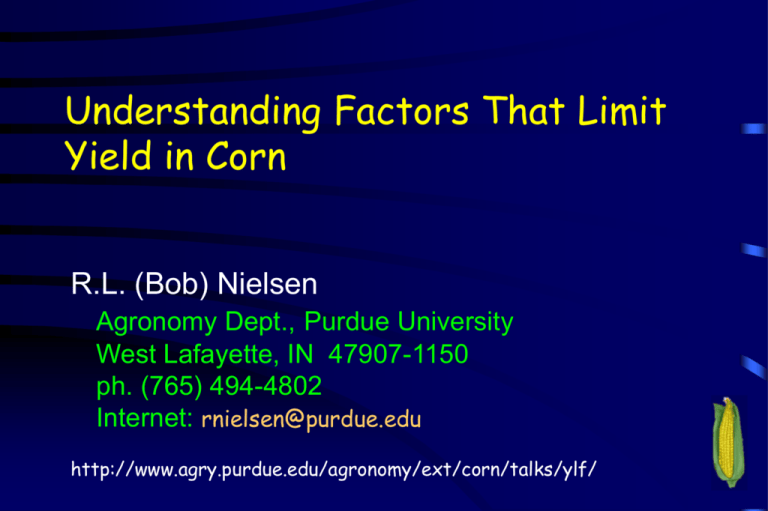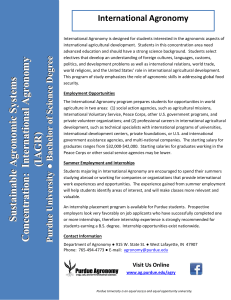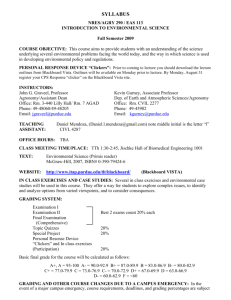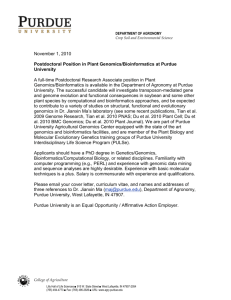Understanding Factors That Limit Yield in Corn
advertisement

Understanding Factors That Limit Yield in Corn R.L. (Bob) Nielsen Agronomy Dept., Purdue University West Lafayette, IN 47907-1150 ph. (765) 494-4802 Internet: rnielsen@purdue.edu http://www.agry.purdue.edu/agronomy/ext/corn/talks/ylf/ Precision Farming: Excitement! • Color maps are fun to look at! • Yield monitors are fun to look at! • Hi-tech wizardry is fun to buy and vendors love to sell it to you! • Landlords are impressed! • Finally, maybe we can finally identify and correct those problem areas in our fields once and for all! Purdue University Agronomy Department 2 Precision Farming: Tools • The tools to manage cropland on a sitespecific basis are here or are being developed rapidly – Yield monitors – Grid soil sampling – Variable rate applicators & seeders – Portable GPS data recorders – Software to ‘massage’ the data Purdue University Agronomy Department 3 Success With PF Technology • Will depend on your ability to identify and manage those yield limiting factors that are most important in each field. – Yield maps alone are not sufficient. – Yield maps can clue you in on where to spend your diagnostic efforts. – Proactive, intentional season-long crop monitoring will be important. Purdue University Agronomy Department 4 Yield Limiting Factors (YLFs) • Crop yields are influenced by vast array of yield limiting factors (YLF) – Some influence yield directly – Some interact with others to influence yield – Some occur every year, others do not – Some influence different crops differently – Weather interacts with most of them Purdue University Agronomy Department 5 Major Categories of Yield-Limiting Factors • • • • Weather Stress Pest Pressures Soil Characteristics Management Practices of... – Farmer – Consultant – Applicator Purdue University Agronomy Department 6 YLF Categories: Weather Stress... Season Length Temp. Rainfall Humidity Sunlight Purdue University Agronomy Department 7 Bragging Rights For Top U.S. Corn Yields? • Which states regularly take top honors for state average corn yields? – Surely, the answer must lie within the major CornBelt states? Yes or no? Purdue University Agronomy Department 8 Bragging Rights For Top U.S. Corn Yields, 1997 150 140 127 133 132 134 120 100 50 USDA est’s as of Nov 1 0 IL IA IN MN Purdue University Agronomy Department NE OH 9 Bragging Rights For Top U.S. Corn Yields, 1997 200 190 140 150 127 133 132 185 175 170 170 134 120 100 50 USDA est’s as of Nov 1 0 IL IA IN MN NE OH WA Purdue University Agronomy Department OR AZ CA NM 10 Basis for High Corn Yields? • Many days of high light intensity – Little rain – Few cloudy days – Little haze • Warm days + cool nights – Less night respiration >>> less dry matter loss Purdue University Agronomy Department 11 YLF Categories: Pest Pressures... Diseases Birds, Deer, etc. Weeds Insects Purdue University Agronomy Department 12 YLF Categories: Soil Characteristics... Tillage Fertility Variability Moisture Tilth Temp. Purdue University Agronomy Department 13 E.B. White, farmer-poet-writer... “A good farmer is nothing more or less than a handy man with a sense of humus.” Purdue University Agronomy Department 14 YLF Categories: Management Practices... Skills Timeliness Hybrid Cultural Purdue University Agronomy Department 15 Cultural Practices... Plant Date Harv. Date Machinery Adj. Seeding Rate Row Spacing Chemical Appl'n Stand Establ. Purdue University Agronomy Department 16 Which YLFs Are Most Important? Tim eliness Variety Plt. Date Rainfall Last year? Seeding Rate Sunlight Row Spacing This field? Hum idity Stand Establ. Air Tem p. Chem ical Appl'n Next year? Soil Tem p. Machinery Adj. That field? Moisture Harv. Date Fertility Diseases Tilth Insects Weeds Purdue University Agronomy Department 17 ‘Perennial’ Yield Limiting Factors • Some yield limiting factors occur every year – Soil fertility or pH patterns – Soil drainage patterns – Patterns of perennial weed growth • These can be identified or attacked with sitespecific technology Purdue University Agronomy Department 18 ‘Sporadic’ Yield Limiting Factors • Other yield limiting factors occur sporadically over the years... – Diseases & insects, even fertility problems are greatly dependent on weather • Site-specific technology can help identify these sporadic problems when they occur, but not necessarily prevent their reoccurrence Purdue University Agronomy Department 19 Identifying YLFs Is Difficult • Requires season-long monitoring – Includes both field observations and crop diagnostics – For precision farming, will require monitoring on site-specific basis Purdue University Agronomy Department 20 Identifying YLFs Is Difficult • Requires season-long monitoring • Requires good note-taking skills – You think you’ve got reams of data from the yield monitor now? Wait until you receive the data from season-long site-specific crop monitoring! Purdue University Agronomy Department 21 Identifying YLFs Is Difficult • Requires season-long monitoring • Requires good note-taking skills • Requires good agronomic skills – Esp. crop diagnostic skills – Ability to integrate layers of agronomic information and relate to yield Purdue University Agronomy Department 22 Field Observations & Crop Diagnostics • Do your homework! – Educate yourself. • Meetings, seminars, demo. plots • Publications, books, magazines, video • CD-ROM programs – Purdue’s Corn Diagnostics CD • World Wide Web – Corn Growers Guidebook http://www.agry.purdue.edu/agronomy/ext/corn/ Purdue University Agronomy Department 23 Field Observations & Crop Diagnostics • Do your homework! • Use “hired gun” expertise – Professional crop consultants – Industry agronomists – County Extension educators – University specialists Purdue University Agronomy Department 24 Field Observations & Crop Diagnostics • Do your homework! • Use “hired gun” expertise • Identify and diagnose crop problems as early as you can, not at the end of the season! – Postmortem diagnoses are difficult, if not impossible! Purdue University Agronomy Department 25 Examples of Field Observations: Planting to Emergence... • Uneven or poor stand establishment – Hybrid weaknesses? – Seed zone stresses? – Insect damage? – Disease damage? – Planter problems? Purdue University Agronomy Department 26 Examples of Field Observations: Emergence to Knee-High... • Uneven plant growth? – Soil tilth, pests? • Poor plant color or vigor? – Hybrid, fertility? • Poor weed control? – Herbicide appl’n? Purdue University Agronomy Department 27 Examples of Field Observations: Knee-High to Tasseling... • Poor or uneven plant growth? – Nutrient deficiencies? – Soil tilth? Purdue University Agronomy Department 28 Examples of Field Observations: Tasseling & Silking... • Uneven pollination success? – Heat/moisture stress? – Insect pests? Purdue University Agronomy Department 29 Examples of Field Observations: Tasseling to Maturity... • Aborted kernels or malformed ears? – Nutrient deficiencies? – Excessive plant populations? – Leaf disease(s) – Drought stress Purdue University Agronomy Department 30 Examples of Field Observations: Maturity to Harvest... • Root and stalk rots? – Hybrid weaknesses? – Excessive plant population? – Nutrient deficiencies? – Earlier defoliation? Purdue University Agronomy Department 31 Examples of Field Observations: Harvest... • Yield variability across field? – Role of yield monitors • Excessive harvest losses? – Hybrid weaknesses? – Combine adjustments? – Grain moisture or harvest date? Purdue University Agronomy Department 32 Beware of the Hazards of Correlations • As you gather more and more information about potential YLFs, be aware that apparent relationships with yield may simply be random chance events…... Purdue University Agronomy Department 33 Ex. of Hazardous Correlation • Every single person who ate asparagus prior to 1865 is now dead, therefore….. • Eating asparagus is hazardous to your health! Purdue University Agronomy Department 34 Real-Life Example #1 “That patch of foxtail sure cut the yield of those soybeans.” Maybe that area of the field was also a low spot that ponded last spring, killed off some of the soybean stand, and the foxtail took advantage of the extra sunlight. So, stand loss rather than foxtail could have been the real culprit. Purdue University Agronomy Department 35 Real-Life Example #2 “My best yields came from an area with twice Purdue’s recommended soil K levels.” Occurred during 1995 drought. Best yielding area was also low, poorly drained area of field. So, maybe the yield response was more due to soil moisture availability differences than to soil potassium levels? Purdue University Agronomy Department 36 Without Season-Long Monitoring, Yield Map Interpretation Can Be Very Difficult Drainage Soil type Insect Disease Fertility Prev. crop Variety Compaction etc. Source: Pioneer Hi-Bred Int’l http://www.pioneer.com/xweb/usa/txt/restech/precision/i971219.htm Purdue University Agronomy Department 37 My Advice? • Hire a good agronomist to be your Sherlock Holmes! • You’ll need the seasonlong expertise to help with the Precision Farming puzzle. Purdue University Agronomy Department 38 Precision Farming: Challenge • It may be that we’ll only be able to fine-tune our crop production to a limited extent with site-specific technology – Identify and correct perennial yield limiting factors such as soil fertility, pH, drainage – Identify and attack certain sporadic yield limiting factors ‘on the go’ • e.g., developing pest or disease problems Purdue University Agronomy Department 39 Precision Farming: Challenge • But, we may be limited when trying to sitespecifically manage those yield limiting factors that interact heavily with seasonal weather patterns – At least, until we can better predict next year’s weather! Purdue University Agronomy Department 40 Let’s Remember... “Farming is a kind of continual miracle wrought by the hand of God.” – -- Benjamin Franklin Purdue Agriculture Purdue University Agronomy Department 41




